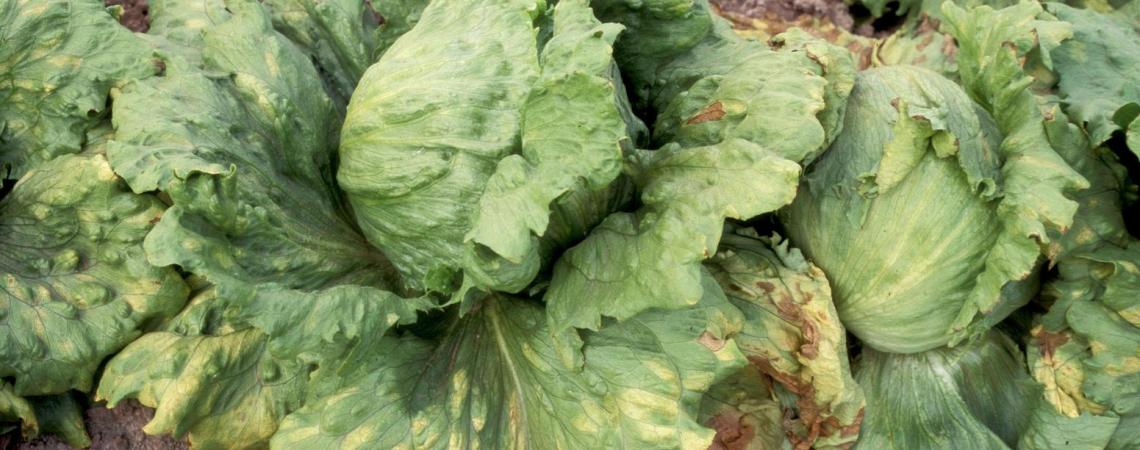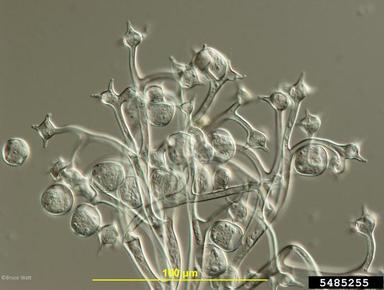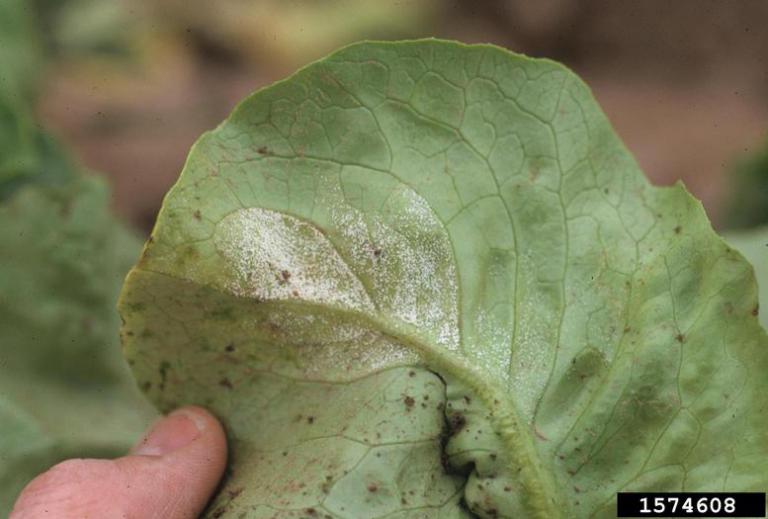
Downy Mildew
On this page
Connected Pages
Downy mildew of lettuce has been a significant challenge to lettuce production for many years and occurs wherever lettuce is produced. Although the incidence of the disease is higher in cool humid areas, it can occur even in desert production areas if conditions are favorable. Symptoms include light green to yellow angular spots on the upper surface of the leaves, with white fluffy growth on the undersurface of the leaf below each spot. The disease typically infects older leaves first and continues to spread to younger tissue. In some cases, the disease can become systemic causing necrosis of the plant stem.
Causal Agent
The disease is caused by the fungus-like organism Bremia lactucae and is found wherever lettuce is grown, with lettuce being the principal host. The pathogen has also been reported to infect several other hosts, but these pathogenic strains appear to be host-specific and do not infect lettuce. Regarding the lettuce pathogenic strains, there exist many races of the pathogen and each race is pathogenic on specific cultivars of lettuce. The pathogen thrives under cool moist conditions and produces an abundance of short-lived spores, which are quickly dispersed during periods of high moisture. In contrast to other species of downy mildew in other cropping systems, Bremia lactucae does not appear to be soilborne.

Management Practices
Cultural Control
Cultural control of the disease is focused on keeping the lettuce foliage as dry as possible for as long as possible, whether in the field or the greenhouse. Irrigation systems such as drip irrigation are useful for reducing periods of leaf wetness, in contrast to overhead sprinkler irrigation. However, under environmental conditions conducive to disease, such as cool mornings with long periods of nighttime leaf wetness, all fields will be susceptible to disease outbreaks. Under such conditions, crop managers need to be actively scouting crops for the first signs of disease.
Chemical Control
There are a number of fungicides that are effective against downy mildew. Products such as mefenoxam and fosetyl-al have long been used for disease control, but new chemistries are being developed as well. Most studies show the common occurrence of fungicide resistance development in local strains of Bremia, therefore, all product use should be accompanied by a robust program of fungicide resistance management. Several low toxicity products exhibiting anti-fungal properties and/or induction of plant host defense responses, such as lipopeptides, have also been shown to be effective and are being used increasingly. Before using any product to control downy mildew on lettuce, check product labels and restrictions and consult with your local Extension Specialists and Pest Control Advisers.
Biological Control
Although downy mildew is an important pathogen on a number of high-value crops such as grape, small berries, and Brassica spp., there has not been the volume of research on biocontrol measures as has been conducted for chemical control measures. Results from studies conducted to date reveal the most promising products are formulations of different bacterial strains including those of Bacillus and Streptomyces. However, levels of control are not as high as those achieved with conventional chemistries. As such, much research is needed in this area.

Breeding for Resistance
The development of downy mildew resistance has been a focus of lettuce breeding activities for many years. There are resistant cultivars available, each resistant to specific races of Bremia lactucae. Some commercial varieties have resistance to many of the races that commonly occur in the West. However, the fungus is genetically variable and new races continue to emerge that can overcome resistance in current varieties. As such, lettuce breeders will need to be vigilant for the emergence of new pathogen races and be prepared to move new resistance genes into commercial cultivars currently in use.
Publications & Links
